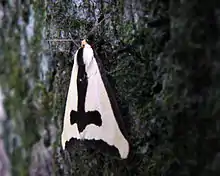Haploa clymene
Haploa clymene, the Clymene moth, is a moth of the tiger moth subfamily - Arctiinae, tribe Arctiini. The species was first described by Peter Brown in 1776. It is found in eastern North America.
| Clymene moth | |
|---|---|
 | |
| Scientific classification | |
| Kingdom: | Animalia |
| Phylum: | Arthropoda |
| Class: | Insecta |
| Order: | Lepidoptera |
| Superfamily: | Noctuoidea |
| Family: | Erebidae |
| Subfamily: | Arctiinae |
| Genus: | Haploa |
| Species: | H. clymene |
| Binomial name | |
| Haploa clymene (P. Brown, 1776) | |
| Synonyms | |
| |
Description
The forewing is creamy yellow with a partial brown-black border that extends inward from the inner margin near anal angle. The hindwing is yellow orange with one or two brown-black spots. The wingspan is 40–55 mm.
Life cycle
The spiny larva is brownish black with a yellow middorsal stripe. The larvae overwinter and mature in the spring and early summer. The larvae feed on Eupatorium, oak, peach and willow. The Clymene moth has one brood per year.
References
External links
| Wikimedia Commons has media related to Haploa clymene. |
- Lotts, Kelly & Naberhaus, Thomas (2017). "Clymene Moth Haploa clymene (Brown, 1776)". Butterflies and Moths of North America. Retrieved August 23, 2019.
This article is issued from Wikipedia. The text is licensed under Creative Commons - Attribution - Sharealike. Additional terms may apply for the media files.